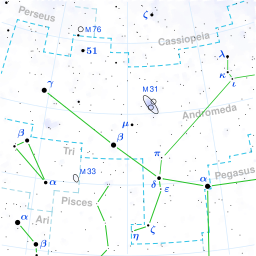What's the most distant object you can see with the naked eye? Unless you live near a dark-sky site (and have exceptional eyesight) the answer is most likely the Andromeda Galaxy. To find it, go outside on a clear, moonless autumn evening and allow a few minutes for your eyes to adjust to the dark. The Andromeda Galaxy is located about midway between the square of Pegasus and the "W" of Cassiopeia.
You should be able to see a faint smudge of light that increases in size when you look slightly to one side of it. (If you're not sure you're looking in the right place, use a pair of binoculars and you should spot it straight away.) That faint smudge of light takes on new meaning when you consider it's a vast complex of stars and dust and gas 220,000 light years across and 2.5 million light years away. It's also barrelling towards us at 110 kilometres per second, so if you hang around a few billion years it's going to get a whole lot bigger and brighter.
In the meantime we'll have to make do with views like the one below. This is an image I made from an hour's worth of exposures using a Canon 80D DSLR and a Tele Vue-60 refractor (focal length approximately 400 mm):
Telescopically, M31 is impressive whatever instrument you point at it, but picking out the kind of detail shown in the photo above is more of a challenge than you might think. On a good night I can see the two dark dust lanes northwest of the core region, and also a vague suggestion of clumpiness in the spiral arms, particularly around the star cloud NGC 206. The two companion galaxies, M32 and the fainter M110, are also easy to spot.
Andromeda and our own Milky Way are the two largest members of the Local Group - a modest collection of at least 50 (mostly dwarf) galaxies occupying a region of space 10 million light years across. Roughly 14 degrees south of M31 is the third largest member of the Local Group, M33 (aka the Triangulum Galaxy). Here's an image I took at the end of August, using the same camera/telescope combination, this time assembled from two hours of data.
Although M33 is only little further away (relatively speaking) than M31 at 2.73 million light years it has a very low surface brightness - and is consequently much harder to see. It's also very sensitive to light pollution. Oddly enough I always found this galaxy easier to spot in a pair of 7x50 binoculars than in my 4-inch refractor. Even on a good night it was vanishingly faint.
In the 10-inch Dobsonian it appears as an extended misty patch of light with a tiny star-like nucleus. On a favourable night I can just about make out the two main spiral arms (the northern one is brighter and easier than the southern one). Higher magnification reveals a prominent misty spot 13 arcminutes northeast of the nucleus (visible as a blue blob in the image above), lurking close to an 11th magnitude foreground star. This is NGC 604, one of the largest star forming regions in the Local Group. It's a whopping 1,500 light years across, which is roughly the distance between here and the Orion Nebula.
Both M31 and M33 have been extensively studied by astronomers using the Hubble Space Telescope and, as you might expect, the images are spectacular:
Hubble's high-definition panoramic view of the Andromeda Galaxy
Triangulum Galaxy shows stunning face in detailed Hubble portrait



